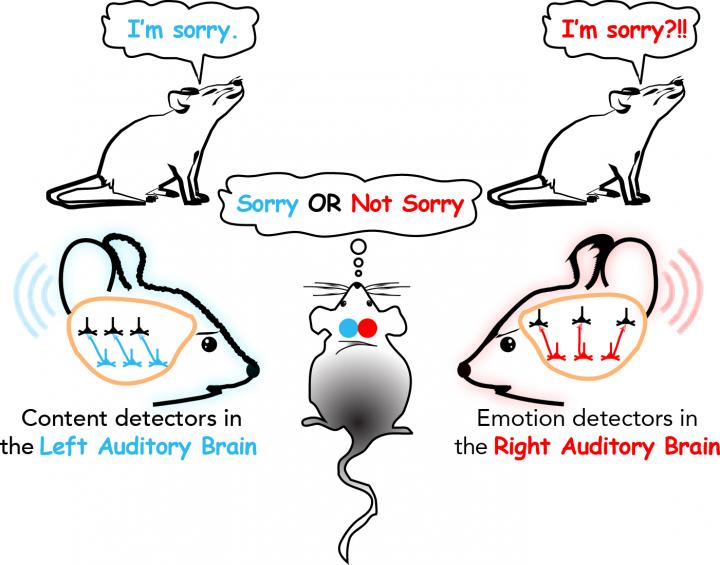The discovery could aid understanding of neurodevelopmental communication disorders

Credit: H. Lebreault
NEW YORK, June 25, 2019 – In the 1860s, French physician Paul Broca published his findings that the brain’s speech production center was located in the left hemisphere. Though scientists have largely accepted since then that the left half of the brain dominates language processing, the reasons behind this lateralization have remained unclear.
“The lateralization of language processing in the auditory cortical areas of the brain has been known for over 150 years, but the function, neural mechanisms, and development of this hemispheric specialization are still unknown,” said Hysell V. Oviedo, a biology professor with The Graduate Center, CUNY and the City College of New York.
A new study from Oviedo’s lab, published in Nature Communications, makes headway into this mystery. Using the mouse as a model system, the researchers observed different specializations between the left and right auditory processing centers of the brain, and found differences in their wiring diagrams that may explain their distinct speech processing functions.
In addition to answering long-standing questions in neuroscience and language processing, the results of Oviedo’s study could someday lead to a better understanding of certain mental health problems. Autism spectrum disorder has been linked to a failure of lateralized language processing to develop between the two halves of the brain. And abnormal lateralization is a risk factor for auditory hallucinations in schizophrenia.
One common feature of mouse vocalizations is syllables with downward jumps in pitch. The left auditory cortex in the mouse showed greater activation in response to these tone sequences, whereas the right auditory cortex appeared to be more of a generalist, responding to any tone sequence. Specializations to detect specific tone sequences prevalent in vocalizations could underlie the left auditory center’s dominance in processing the content or meaning of speech. While the right auditory center’s generalist scheme could underlie its dominance in processing the intonation or prosody of speech.
Notably, the specialized differences between the left and right sides are not innate. Rather, Oviedo says, the differences between their circuitry depend on the acoustic environment in which the mouse was raised.
“Our discovery of the differences in the wiring diagram provides the opportunity to study the molecular phenotypes that shape the development of vocalization processing and how it goes awry in neurodevelopmental communication disorders,” Oviedo said.
Through a battery of experiments such as 3D whole-brain imaging, electrophysiology, and optogenetics, the researchers analyzed properties including synaptic connectivity, axonal projections and development of both hemispheres. “Our study is the first to show that there are significant differences in the wiring diagram of the language centers in the brain that could underlie their distinct speech processing capabilities,” Oviedo said.
###
About The Graduate Center of The City University of New York
The Graduate Center, CUNY is a leader in public graduate education devoted to enhancing the public good through pioneering research, serious learning, and reasoned debate. The Graduate Center offers ambitious students more than 40 doctoral and master’s programs of the highest caliber, taught by top faculty from throughout CUNY — the nation’s largest public urban university. Through its nearly 40 centers, institutes, initiatives, and the Advanced Science Research Center, The Graduate Center influences public policy and discourse and shapes innovation. The Graduate Center’s extensive public programs make it a home for culture and conversation.
Media Contact
Shawn Rhea
[email protected]
Related Journal Article
http://dx.




